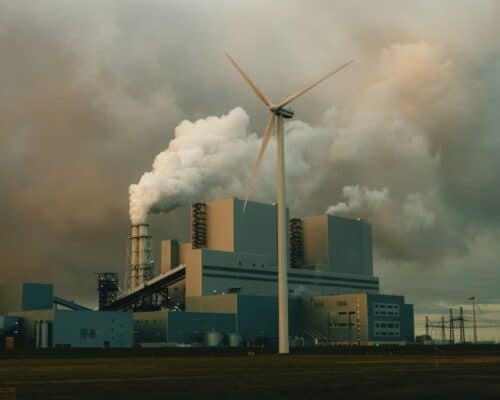IEA: Urgent and Joint Action Needed To Keep the 1.5°C Target Alive
23 October 2023 – by Viktor Tachev
While global warming is a degree lower than before the Paris Agreement, the change is too slow to align with the 1.5°C target. With current policies, we are still on course to hit 2.4°C in warming by 2100. The IEA’s latest report concludes that the world is on the right path to achieving the 1.5°C goal, but this path is quickly narrowing. The world needs a stronger ambition and more proactive cooperation between advanced economies and developing nations to reach its targets.
Net Zero by 2050: A Report by the IEA
In 2021, the IEA published its landmark report, Net Zero by 2050: A Roadmap for the Global Energy Sector. It provided a clear roadmap, with 400 milestones for decarbonising the global energy sector and limiting global warming to 1.5°C.
The report identified that the energy sector, responsible for 75% of global emissions, is key to averting climate change’s worst impacts. As such, the sector’s decarbonisation was highlighted as a priority for governments.
The authors warned that the 1.5°C target remained far out of reach despite gaining traction in global commitment and action. Among the milestones for getting there was the massive deployment of all available clean energy technologies by 2030. The report called for annual additions of 630 GW in solar and 390 GW in wind by 2030. By 2050, almost 90% of global electricity generation would have to come from renewables. Solar PV and wind together were projected to account for nearly 70%.
The agency signalled the need for all governments to strengthen and successfully implement their climate-related policies. It called for tripling clean energy investment worldwide to around USD 4 trillion by 2030.
Regarding fossil fuels, the report called for halting sales of new internal combustion engine passenger cars by 2035. It also urged phasing out all unabated coal and oil power plants by 2040. The report called on governments to stop investing in new fossil fuels and to slash their use from 80% in 2021 to slightly over 25% by 2050.
The 2021 report concluded that the pathway was narrow but achievable.
The Net-zero Roadmap 2023 Update: What Has Changed?
According to the 2023 update of the report, the path toward limiting global warming to 1.5°C has narrowed even further. However, the record amount of clean energy growth provides the hope that the energy sector can reach zero emissions. The IEA concludes that the clean energy transition is gathering pace due to a range of factors, including the push to meet climate targets, the strong economic case for clean energy, the energy security imperatives and the jobs and industrial opportunities the transition will open.
While the report’s overall tone is optimistic, it highlights the need for strengthened policy ambitions and global cooperation.
Clean Energy Technology Adoption and Development Is on the Rise
The IEA’s 2023 update notes that since the initial report, clean energy technology adoption has surged unprecedentedly. Meanwhile, solar PV capacity additions have increased by nearly 50%, way ahead of the trajectory predicted in the 2021 edition’s net-zero scenario. Since 2020, electric car sales and stationary battery installations have jumped by 240% and 200%, respectively.
There are also positive developments regarding the global manufacturing capacity of green technologies. If the announced projects proceed, solar PV and EV battery production capacity will meet demand in 2030. According to the IEA, such developments can ensure a third of the needed emission reductions by 2030.
Another positive development is that, between 2010 and 2022, cost reductions in solar PV, wind, heat pumps and batteries reached 80%.
Furthermore, this has also helped deliver more options to the market. For example, in the report’s 2021 edition, conceptual green technologies accounted for 50% of emissions reductions. Today, they account for 35%.
However, more work needs to be done this decade. The IEA estimates that a net-zero pathway requires global clean energy capacity to triple to 11,000 GW by 2030. This move will be the most significant driver of emissions reductions this decade.
According to the IEA, EVs will account for two-thirds of all new car sales by 2030. Heat pump sales will rise significantly, while the annual rate of energy efficiency improvements is likely to double. On a path to net zero, the agency calls for annual global clean energy investments to jump from USD 1.8 trillion in 2023 to USD 4.5 trillion by the early 2030s.
On the other hand, a failure to expand clean energy quickly enough by 2030 would require removing nearly 5 billion tonnes of CO2 from the atmosphere every year during the second half of this century. This would be a very costly process.
Emerging Technologies Are Insufficient
According to the IEA, emerging technologies, such as hydrogen and CCUS, have a place in the transition to cut emissions but will mainly play a role after 2030. The agency estimates that if all announced projects for hydrogen electrolysis capacity go live, they would meet around 70% of the needs of the NZE scenario by 2030. Announced CCUS projects, on the other hand, would only provide 40% of what is needed by 2030 globally.
New Fossil Fuel Infrastructure is Unnecessary
According to the IEA, a net-zero scenario means no new coal mines, unabated coal plants or long lead-time upstream oil and gas projects. The agency also stresses the importance of the early retirement or repurposing of coal-fired power plants.
The IEA warns that new fossil fuel infrastructure will face significant commercial risks if the world successfully reduces fossil demand quickly enough and reaches net zero by 2050.
Greenhouse Gas Emissions at Record-high Levels
The IEA’s 2023 market update notes that although emissions in 2022 reached an all-time high, demand for coal, oil and natural gas will peak by 2030, even without any new climate policies. However, this won’t be enough to keep the 1.5°C target in sight. Instead, the agency calls for a huge, policy-driven ramping up of clean energy capacity, resulting in 35% lower emissions and 25% lower fossil fuel demand by 2030. By 2050, the latter should drop by 80%.
The report also highlights that the energy sector’s CO2 emissions reached a record of 37 gigatonnes in 2022. Instead of starting to fall, as envisaged in the 2021 report, fossil fuel demand has increased due to the energy crisis and the war in Ukraine.
The IEA estimates that emissions must decline by 80% in advanced economies and 60% in developing economies by 2035. The 2023 report calls for energy sector methane emissions to fall by 75% by 2030. The agency describes this as “one of the least cost opportunities to limit global warming in the near term”. Such a reduction will cost the oil and gas industry USD 75 billion in cumulative spending to 2030, or just 2% of its 2022 net income.
A Call For More Ambitious Policies and Developed Markets to Lead by Example
The IEA warns that current NDCs are not in line with countries’ net-zero pledges. Furthermore, these NDCs are insufficient for putting the world on an NZE pathway by 2050.
The agency calls for all countries to speed up permitting, develop electricity grids and securely integrate variable renewables. It also notes that solar PV and wind, in particular, are widely available, rapidly deployable and cost-effective.
The IEA highlights advanced economies and China as shining examples of ambitious policy frameworks. Thanks to their ambitious efforts, they are expected to reach around 85% of the required renewable capacity by 2030. However, the report also acknowledges the need for stronger policies and international support in other developing economies.
The report calls for advanced economies to reach net zero sooner to grant developing nations more time to ensure a just transition. The report also highlights the need to consider national circumstances when it comes to the energy transition.
Need For Increased Investment in Emerging and Developing Markets
The IEA notes that over 80% of the clean energy investments today are made in advanced economies and China.
In an NZE scenario, overall clean energy investments should triple by 2030. Aside from China, emerging markets and developing economies should jump fivefold. The IEA estimates that staying on track with the 1.5°C requires mobilising annual concessional clean energy funding of around USD 80-100 billion in emerging and developing countries by the early 2030s.
According to the agency, the needed clean energy investments in a net-zero scenario will be outweighed by declines in fossil fuel spending. As a result, the net energy spending savings will top USD 12 trillion by 2050. Furthermore, total household energy expenditure in emerging markets and developing economies will drop by 12% and even more in advanced economies by 2030.
Communities across Southeast Asia would welcome such a development, considering their struggle with the fossil fuel crisis and some governments’ plans to further lock in in gas dependence.
COP28 Will Either Bring Us Closer to the 1.5°C Target or Push It Further Away
“The COP28 climate summit in Dubai is a vital opportunity to commit to stronger ambition and implementation in the remaining years of this critical decade,” says IEA Executive Director Fatih Birol.
In less than two months, we will see whether those words spark positive momentum or fall on deaf ears.
To retain the hope of limiting global warming to 1.5°C, the IEA calls for the mass adoption of proven and cost-effective technologies capable of lowering emissions. Such a strategy would deliver over 80% of the reductions needed by 2030. This makes the adoption of costly and inefficient technologies like ammonia co-firing, CCUS and hydrogen for the power sector out of the question.
The IEA warns that delaying action would cost the world USD 1.3 trillion annually – 50% more than what was invested in fossil fuels in 2022. And this is without considering the price that the most vulnerable communities are paying daily while the world stalls on climate change action. At COP28, governments, policymakers and companies will collectively decide whether this continues to happen.
by Viktor Tachev
Viktor has years of experience in financial markets and energy finance, working as a marketing consultant and content creator for leading institutions, NGOs, and tech startups. He is a regular contributor to knowledge hubs and magazines, tackling the latest trends in sustainability and green energy.
Read more



